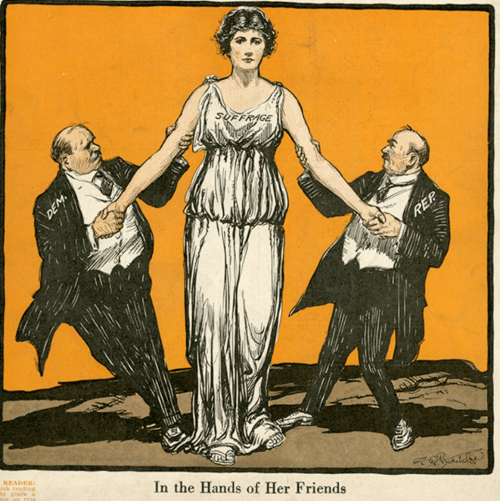As the first political cartoonist ever to win a Pulitzer Prize, Clarence Daniel “C. D.” Batchelor thought having been born on April Fool’s Day (in 1888) was appropriate to his calling. The cane-collecting (he died owning more than 500), dapper, Kansas-born, self-styled “character” – “It was just as easy to be a character as not to be one,” he said, “and a hell of a lot more fun!”– used art and irony to speak truth to power throughout a long career. During most of that career, he provided daily editorial cartoons for the New York Daily News.


Batchelor was a lifelong advocate for women’s rights, and included idealized, romanticized images of confident and capable modern women in much of his work. During his 20s, a majority of his production was created in support of woman suffrage. He produced illustrations and cover art for such publications as the National American Woman Suffrage Association Newsletter, The Woman Citizen, the Woman’s Journal and Suffrage News and The Woman Voter. In a 1920 interview in The Woman Citizen, Batchelor said artists had had to completely recreate the images of women used in magazines over the past 15 years because of the “assurance and confidence born of a changed and changing economic status and her approaching political freedom.” When asked about the ideal of the American girl he tried to draw, he said, “I cannot imagine her but intelligent and of aggressive opinion when the Soviet, industrial democracy, or Ibanez is discussed.”

In later years, Batchelor, like the paper he worked for, took an isolationist stance towards the United States’ possible entry into World War II. His breakthrough 1937 Pulitzer Prize winning cartoon depicting a female skeleton prostitute (War) enticing a young man (“Any European Youth”) with the line, “Come on in, I’ll treat you right, I used to know your daddy,” reflected that anti-war stance.
After Pearl Harbor, and for the rest of his career, Batchelor’s work displayed an earnest wartime patriotism, and later, fervent anti-communism. In 1943, for his then-country-home town of Deep River, he created the artwork that is the centerpiece of the Honor Roll of Deep River citizens who served in war.
An admirer and artistic creator of the ideal 20th-century woman, Batchelor seems to have spent his life looking for the real-life incarnation of his artistic creation. A batchelor in name only, when he died in Deep River on September 6, 1977 at 89, he was survived by his fifth wife, Allegra.


Further Reading
“C. D. Batchelor, Social Welfare History Project,” VCU Libraries
“Obituary for C. D. Batchelor,” newspapers.com
“Resident: C. D. Batchelor,” Tudor City Confidential
“Deep River Historical Society Hosts Cartoonist C. D. Batchelor Exhibit . . .,” ValleyNewsNow.com
Mike Rhode, “C. D. Batchelor’s Anti-VD Campaign” comicsdc.blogspot.com

